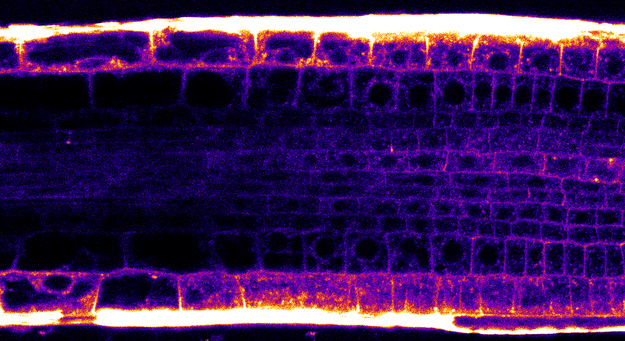Direct Insight into the Life of Roots
The hormone auxin (or a group of substances with a similar structure and function) is found in all higher plants and plays a crucial role in formation and function of the plant body. Auxin is also indispensable for plant tropisms, growth movements whereby a plant leans towards or away from an attractant (such as sunflowers do towards the sun). Since Dr. Fendrych’s team at FSc CU focuses on the elucidation of mechanisms of root growth, one of their main focus is the way that a plant’s root orientates with regard to the arth gravity, or gravitropism. “Gravity is the first thing that a growing plant root uses if it has no other navigation clues – such as water,” Matyáš Fendrych explains.
 Optical section through the root tip of a goosefoot (Arabidopsis thaliana) in which cells are highlighted according to membrane potential; the stronger the signal, the more depolarized the plasma membrane. Photo: Nelson BC Serre, Cell Growth Lab
Optical section through the root tip of a goosefoot (Arabidopsis thaliana) in which cells are highlighted according to membrane potential; the stronger the signal, the more depolarized the plasma membrane. Photo: Nelson BC Serre, Cell Growth Lab
The root cap at the very tip of the root is the site of gravity sensing. The actual reaction to gravity, however, happens at a different place in the root known as the elongation zone. For the plant to react correctly, the two places must have an information link. It is a known that the phytohormone auxin provides the information link between both zones. When the root cap detects a change in gravity direction (if the root takes a wrong turn), it sends an auxin signal to the bottom of the root that “tells” the local cells to stop growing, so that the root can correct the direction it is growing in.
What happens in the elongation zone between the release of the auxin signal from the root cap and the stopping of the growth is a challenge for today’s science with many unresolved issues. Thanks to the work of many scientists, we know today the principle of how the cells’ “classical” response to auxin works. In this scenario, auxin links to a receptor, triggering a cascade of molecular processes. The result is the transcription (activation) of certain genes that lead to the cell’s reaction. Such reaction takes at least five minutes. Besides that, there are also very rapid responses to auxin – ones that take lower tens of seconds – and their molecular mechanism or importance for root gravitropism are still unknown. “During my previous work at IST (Institute for Science and Technology) in Klosterneuburg, Austria, I found that cellular reaction to auxin can be surprisingly rapid, which is at odds with our understanding of the auxin signalling pathway,” Dr. Fendrych describes the genesis of the issue currently under research. “This is exactly the issue that our team is trying to resolve – and our new article takes us closer to understanding the mechanism of the rapid response to auxin,” Dr. Fendrych says.
The scientists returned to nearly forgotten observations that plant physiologists made back in the “pre-molecular” era, which showed that the presence of auxin changes the distribution of the electric charge on both sides of the cellular membrane, known as plasma membrane potential. The membrane potential is crucially important for the life of a cell. Among other things, it helps cells to transport various substances inside, thus influencing its metabolic and signalling actions. “Several earlier papers have shown that the presence of auxin can change the balance of charges on the membrane (or depolarise it), thus influencing membrane transport. To date, however, no one examined why this i actually happens and how important depolarisation is for root gravitropism,” describes Dr. Fendrych.
Dr Fendrych’s lab’s long-term focus has been precise quantitative “live-cell imaging”, or observing processes in living plants and their cells in real time. It is especially important with plants to examine the spatial characteristics of growth while incorporating information about time in the analysis. Nelson Serre, a postdoc from France and the first author of the study, did a lion’s share of work on the article. Dr Serre used a fluorescence spinning disk microscope, which is specially modified to allow for the observation of root growth and behaviour in real time with the roots oriented towards gravity. Using DISBAC2(3), a fluorescent dye that acts as a membrane potential sensor, he was able to observe how the cells membrane potential across the root responds to auxin while precisely quantifying the process. “With this approach, we were able to transform the issue of measuring potential, which required invasive electrodes in the past, into an issue that could be resolved using a microscope. This way, it is possible to observe and quantify these processes directly in a living plant without having to disrupt it. This paper allowed us to measure the cells membrane potential across the entire root and its changes in time. While they appear static at a glance, plants constantly monitor their environment and continuously adjust their internal state to optimize growth and development and these adjustments can be very rapid.The depolarisation of cellular membranes during gravitropism is a fascinating example of this,” Dr Serre explains.
 Lead author of the study, Dr. Matyáš Fendrych, and first author, Dr. Nelson Serre. Photo: Eva Medvecká
Lead author of the study, Dr. Matyáš Fendrych, and first author, Dr. Nelson Serre. Photo: Eva Medvecká
“Our approach for measuring membrane potential is useful for other scientists who can use it in their research. A huge benefit of our paper was the quantification of microscopic data and their dynamics in time. This way, nice images give you precise data that allow you to detect what exactly is happening within the plant on a cellular and molecular level,” Dr. Matyáš Fendrych sums up the results of many months’ worth of work.
Document Actions